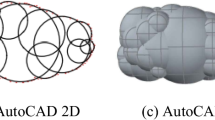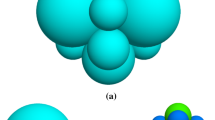Abstract
In this study, the effects of particle sphericity and initial fabric on the shearing behavior of soil-structural interface were analyzed by discrete element method (DEM). Three types of clustered particles were designed to represent irregular particles featuring various sphericities. The extreme porosities of granular materials composed of various clustered particles were affected by particle sphericity. Moreover, five specimens consisting of differently oriented particles were prepared to study the effect of initial fabric. A series of interface shear tests featuring varying interface roughnesses were carried out using three-dimensional (3D) DEM simulations. The macro-response showed that the shear strength of the interface increased as particle sphericity decreased, while stress softening and dilatancy were easily observed during the shearing. From the particle-scale analysis, it was found that the thickness of the localized band was affected by the interface roughness, the normal stress and the initial fabric while independent of the particle sphericity. The thickness generally ranged between 4 and 6 times that of the median particle equivalent diameter. A thicker localized band was formed in the case of rougher interface and in soil composed of inclined placed and randomly placed particles. The coordination number measured in the interface zone and upper zone suggested that the dilation mostly occurs inside the interface zone. Anisotropy was induced by the interface shearing of the initial isotropic specimens. The direction of shear-induced anisotropy correlates with the shearing direction. The evolutions of anisotropies for the anisotropic specimens depend on the initial fabric.
























Similar content being viewed by others
References
Ai J, Chen JF, Rotter JM, Ooi JY (2011) Assessment of rolling resistance models in discrete element simulations. Powder Technol 206(3):269–282
Barreto D, O’Sullivan C, Zdravkovic L (2009) Quantifying the evolution of soil fabric under different stress paths. In: AIP conference proceedings, London, pp 181–84
Bono JP, Mcdowell GR (2015) An insight into the yielding and normal compression of sand with irregularly-shaped particles using DEM. Powder Technol 271:270–277
Chang CS, Yin ZY (2009) Micromechanical modeling for inherent anisotropy in granular materials. J Eng Mech 136(7):830–839
Chen X, Zhang J, Xiao Y, Li J (2015) Effect of roughness on shear behavior of red clay—concrete interface in large-scale direct shear tests. Can Geotech J 52(8):1122–1135
Cho GC, Dodds J, Santamarina JC (2006) Particle shape effects on packing density, stiffness and strength: natural and crushed sands. J Geotech Geoenviron Eng 132(5):591–602
Coetzee CJ (2016) Calibration of the discrete element method and the effect of particle shape. Powder Technol 297:50–70
Cundall PA, Strack ODL (1979) A discrete numerical model for granular assemblies. Géotechnique 29(1):47–65
Dejong JT, White D, Randolph MF (2006) Microscale observation and modeling of soil-structure interface behavior using particle image. Soils Found 46(1):15–28
Frost JD, Dejong JT, Recalde M (2002) Shear failure behavior of granular-continuum interfaces. Eng Fract Mech 69(17):2029–2048
Hossain MA, Yin JH (2014) Behavior of a pressure-grouted soil-cement interface in direct shear tests. Int J Geomech 14(1):101–109
Hu LM, Pu JL (2005) Testing and modeling of soil-structure interface. J Geotech Geoenviron Eng 130(8):851–860
Iwashita K, Oda M (1998) Rolling resistance at contacts in simulation of shear band development by DEM. J Eng Mech 124(3):285–292
Jensen RP, Bosscher PJ, Plesha ME, Edil TB (1999) DEM simulation of granular media-structure interface: effects of surface roughness and particle shape. Int J Numer Anal Meth Geomech 23(6):531–547
Jiang M, Yin ZY (2012) Analysis of stress redistribution in soil and earth pressure on tunnel lining using the discrete element method. Tunn Undergr Space Technol 32:251–259
Jiang M, Yin ZY (2014) Influence of soil conditioning on ground deformation during longitudinal tunneling. CR Mec 342(3):189–197
Jing XYWH, Zhou HXZhu, Yin ZY (2018) Analysis of soil-structural interface behavior using three-dimensional DEM simulations. Int J Numer Anal Meth Geomech 42(2):339–357
Jing XY, Zhou WH, Li YM (2017) Interface direct shearing behavior between soil and saw-tooth surfaces by DEM simulation. Procedia engineering. Delft, The Netherlands, pp 36–42
Krumbein WCh, Sloss LL (1951) Stratigraphy and sedimentation. LWW
Lin X, Ng TT (1997) A three-dimensional discrete element model using arrays of ellipsoids. Géotechnique 47(2):319–329
Lu M, Mcdowell GR (2007) The importance of modelling ballast particle shape in the discrete element method. Granular Matter 9(1–2):69–80
Mindlin RD, Deresiewicz H (1953) Elastic spheres in contact under varying oblique forces. J Appl Mech 20:327–344
Miura K, Maeda K, Furukawa M, Toki S (1998) Mechanical characteristics of sands with different primary properties. Soils Found 38(4):159–172
Nakata Y et al (2001) One-dimensional compression behaviour of uniformly graded sand related to single particle crushing strength. Soils Found 41(2):39–51
Ni Q, Powrie W, Zhang X, Harkness R (2000) Effect of particle properties on soil behavior: 3-D numerical modeling of shearbox tests. In: Numerical methods in geotechnical engineering, ASCE Geotechnical Special Publication, pp 58–70
Ochiai H, Otani J, Hayashic S, Hirai T (1996) The pull-out resistance of geogrids in reinforced soil. Geotext Geomembr 14(1):19–42
Oda M, Nemat-Nasser S, Konishi J (1985) Stress-induced anisotropy in granular masses. Soils Found 25(3):85–97
Paikowsky SG, Player CM, Connors PJ (1995) A dual interface apparatus for testing unrestricted friction of soil along solid surfaces. ASTM Geotech Test J 18(2):168–193
Peng SY, Ng CWW, Zheng G (2014) The dilatant behaviour of sand-pile interface subjected to loading and stress relief. Acta Geotech 9(3):425–437
Pra-ai S, Boulon M (2017) Soil-structure cyclic direct shear tests: a new interpretation of the direct shear experiment and its application to a series of cyclic tests. Acta Geotech 12(1):107–127
Rao KSS, Allam MM, Robinson RG (1998) Interfacial friction between sands and solid surfaces. In: Proceedings of the ICE–geotechnical engineering, pp 75–82
Rothenburg L, Bathurst RJ (1992) Micromechanical features of granular assemblies with planar elliptical particles. Géotechnique 42(1):79–95
Salot C, Gotteland P, Villard P (2009) Influence of relative density on granular materials behavior: DEM simulations of triaxial tests. Granular Matter 11(4):221–236
Santamarina JC, Cho GC (2004) Soil behaviour: the role of particle shape. In: Advances in geotechnical engineering: the Skempton conference, London, pp 604–17
Satake M (1992) A discrete-mechanical approach to granular materials. Int J Eng Sci 30(10):1525–1533
Su LJ, Yin JH, Zhou WH (2010) Influences of overburden pressure and soil dilation on soil nail pull-out resistance. Comput Geotech 37(4):555–564
Su LJ, Zhou WH, Chen WB, Jie X (2018) Effects of relative roughness and mean particle size on the shear strength of sand-steel interface. Measurement 122:339–346
Uesugi M, Kishida H (1986) Frictional resistance at yield between dry sand and mild steel. Soils Found 26(4):139–149
Uesugi M, Kishida H (1986) Influential factors of friction between steel and dry sands. Soils Found 26(2):33–46
Uesugi M, Kishida H, Tsubakihara Y (1988) Behavior of sand particles in sand-steel friction. Soils Found 28(1):107–118
Wang HL, Chen RP, Liu QW, Kang X, Wang YW (2019) Soil–geogrid interaction at various influencing factors by pullout tests with applications of FBG sensors. J Mater Civil Eng 31(1):04018342
Wang J, Gutierrez MS, Dove JE (2007) Numerical studies of shear banding in interface shear tests using a new strain calculation method. Int J Numer Anal Meth Geomech 31(12):1349–1366
Wang J, Jiang M (2011) Unified soil behavior of interface shear test and direct shear test under the influence of lower moving boundaries. Granular Matter 13(5):631–641
Wensrich CM, Katterfeld A (2012) Rolling friction as a technique for modelling particle shape in DEM. Powder Technol 217:409–417
Wood DM, Maeda K (2007) Changing grading of soil: effect on critical states. Acta Geotech 3(1):3–14
Wu XY, Yang J (2016) Direct shear tests of the interface between filling soil and bedrock of Chongqing airport. In: Advances in civil, envrionmental, and materials research (ACEM16), Jeju Island
Yin JH, Zhou WH (2009) Influence of grouting pressure and overburden stress on the interface resistance of a soil nail. J Geotech Geoenviron Eng 135(9):1198–1208
Yin ZY, Chang CS, Hicher PY (2010) Micromechanical modelling for effect of inherent anisotropy on cyclic behaviour of sand. Int J Solids Struct 47(14):1933–1951
Zhao LS, Zhou WH, Yuen KV (2017) A simplified axisymmetric model for column supported embankment systems. Comput Geotech 92:96–107
Zhou J, Gong X, Wang K, Zhang R (2018) Shaft capacity of the pre-bored grouted planted pile in dense sand. Acta Geotech 13(5):1227–1239
Zhou WH, Yin JH (2008) A simple mathematical model for soil nail and soil interaction analysis. Comput Geotech 35(3):479–488
Zhou WH, Yin JH, Hong CY (2011) Finite element modelling of pullout testing on a soil nail in a pullout box under different overburden and grouting pressures. Can Geotech J 48(4):557–567
Zhou WH, Yuen KV, Tan F (2013) Estimation of maximum pullout shear stress of grouted soil nails using bayesian probabilistic approach. Int J Geomech 13(5):659–664
Zhu HX, Zhou WH, Yin ZY (2018) Deformation mechanism of strain localization in 2D numerical interface tests. Acta Geotech 13:557–573
Acknowledgements
The authors wish to thank the financial support from the Macau Science and Technology Development Fund (FDCT) (125/2014/A3), the National Natural Science Foundation of China (Grant No. 51508585/51678319), the University of Macau Research Fund (MYRG2017-00198-FST, MYRG2015-00112-FST) and Marie Skłodowska-Curie Actions Research and Innovation Staff Exchange Programme (Grant No. 778360).
Author information
Authors and Affiliations
Corresponding author
Additional information
Publisher's Note
Springer Nature remains neutral with regard to jurisdictional claims in published maps and institutional affiliations.
Rights and permissions
About this article
Cite this article
Zhou, WH., Jing, XY., Yin, ZY. et al. Effects of particle sphericity and initial fabric on the shearing behavior of soil–rough structural interface. Acta Geotech. 14, 1699–1716 (2019). https://doi.org/10.1007/s11440-019-00781-2
Received:
Accepted:
Published:
Issue Date:
DOI: https://doi.org/10.1007/s11440-019-00781-2




